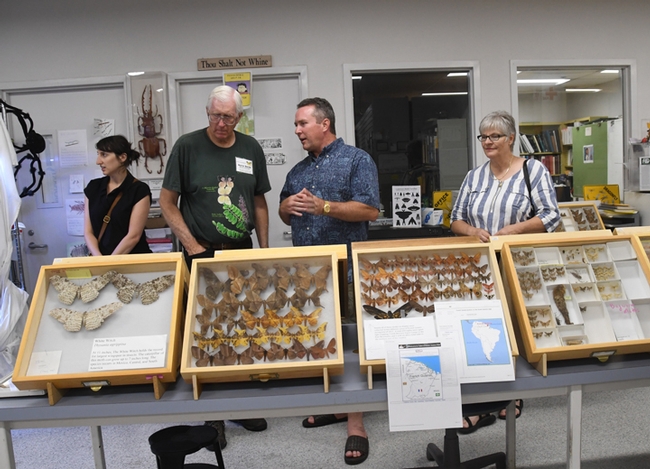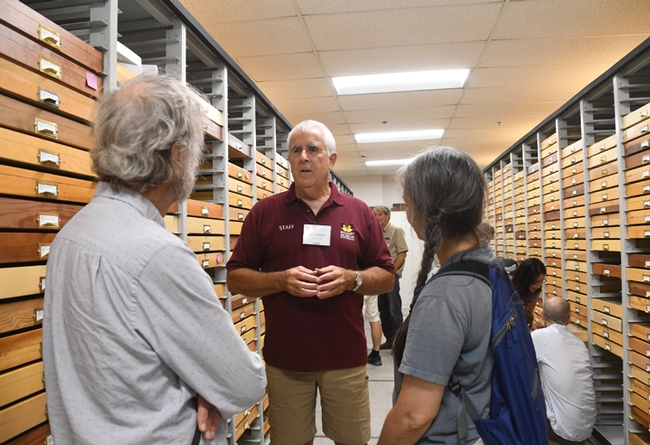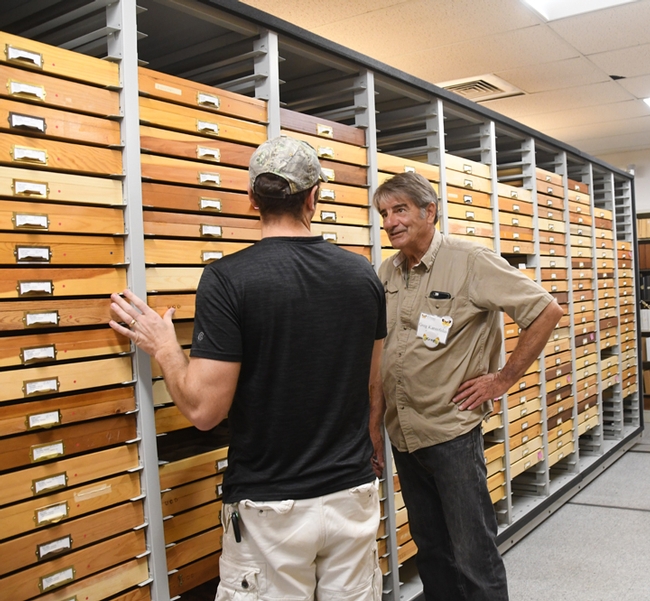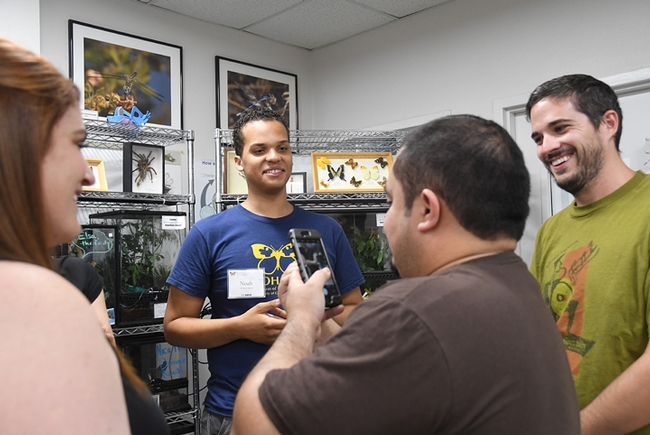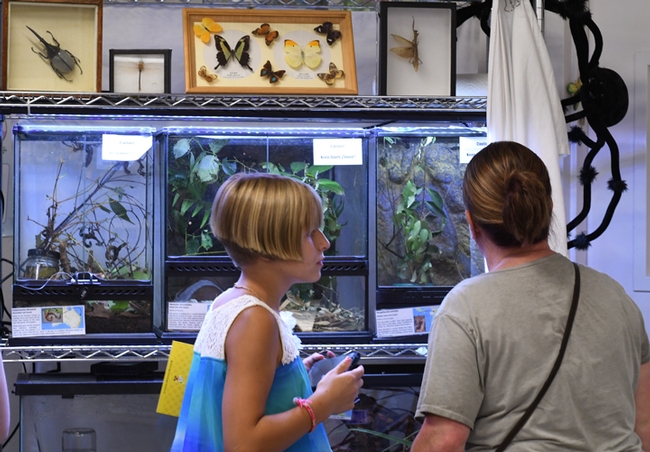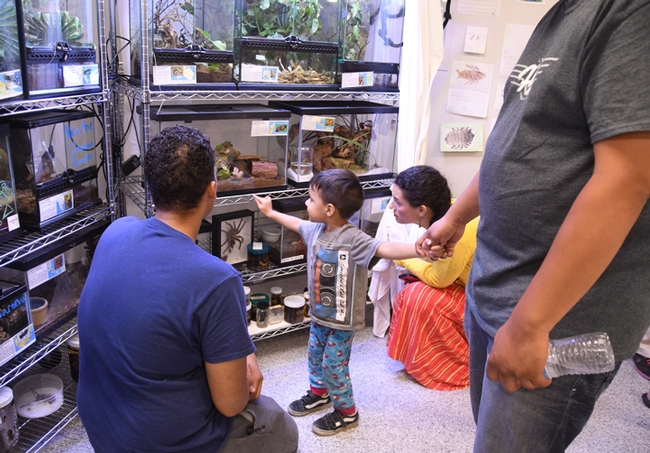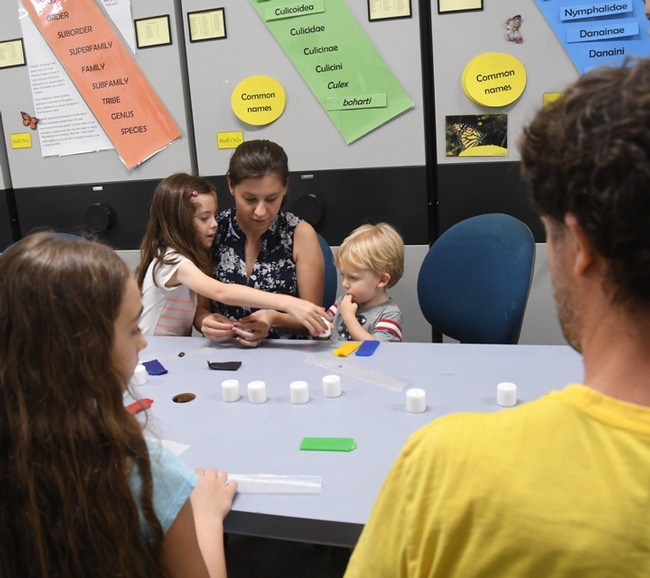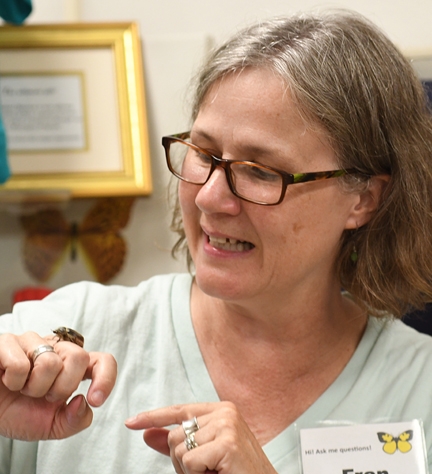- Author: Kathy Keatley Garvey

You're in luck.
The Bohart Museum of Entomology, located in Room 1124 of the Academic Surge Building on Crocker Lane, UC Davis campus, will host four public events from May 28 through July 16. All are free and open to the public. Parking is also free.
Saturday, May 28, 1 to 4 p,m.
Open house, "Bugs in Ag: What Is Eating Our Crops and What Is Eating Them?"
Cooperative Extension specialist and agricultural entomologist Ian Grettenberger of the UC Davis Department of Entomology and Nematology faculty will explore the relationships between insects and agriculture. His areas of expertise include field crops; vegetable crops; insects, mites and other arthropods affecting plants; biological control of pests affecting plants; and beneficial insects. Grettenberger, who joined the UC Davis faculty in January 2019, targets a wide variety of pests, including western spotted and striped cucumber, beetles, armyworms, bagrada bugs, alfalfa weevils, aphids, and thrips.
Saturday June 25, 1 to 4 p.m.
Open house, "Eight-Legged Encounters"
This event is all about arachnids featuring scientists from across the country. It is in collaboration with the American Arachnological Society's 2022 meeting, scheduled June 26-30 on the UC Davis campus. The annual meeting will be hosted by two UC Davis arachnologists: Jason Bond, the Evert and Marion Schlinger Endowed Chair in Insect Systematics, UC Davis Department of Entomology and Nematology, and associate dean, College of Agricultural and Environmental Sciences, and Joel Ledford, assistant professor of teaching, Department of Plant Biology, College of Biological Sciences.
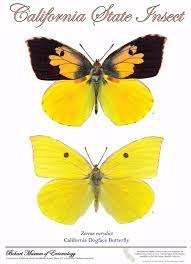
Public event to be held in California Hall for arachnid novices and experts alike. This is in collaboration with the American Arachnological Society's meeting at UC Davis.
Saturday, July 16, 1 to 4 p.m.
"Celebrating 50 Years of the Dogface Butterfly:California's State Insect"
Scientists and the public will celebrate the 50th anniversary of the California State Legislature' designation of the dogface butterfly as the state insect.
Folsom Lake College professor and Bohart scientist Fran Keller, and Bohart associate Greg Karofelas, a volunteer docent for the Placer Land Trust's dogface butterfly tours, will on hand to discuss the butterfly. The California dogface butterfly, Zerene eurydice, is found only in California. It thrives in the 40-acre Shutamul Bear River Preserve near Auburn, Placer County. The preserve, part of the Placer Land Trust, is closed to the public except for specially arranged tours.
Keller is the author of 35-page children's book, The Story of the Dogface Butterfly, with photos by Keller and Kareofelas, and illustrations by former UC Davis student Laine Bauer. Kareofelas' images include the life cycle of the dogface butterfly that he reared. Keller holds a doctorate in entomology from UC Davis, where she studied with major professor Lynn Kimsey, director of the Bohart and UC Davis distinguished professor of entomology.
Kareofelas and Keller also teamed to create a dogface butterfly poster of the male and female. Both the book and the poster are available online from the the Bohart Museum of Entomology gift shop.
California legislators adopted the dogface butterfly as the official state insect on July 28, 1972. But as early as 1929, entomologists had already singled it out as their choice for state insect. Their suggestion appears in the California Blue Book, published by the State Legislature in 1929. (Read more on how the butterfly became the state insect under the Ronald Reagan administration.)
The dogface butterfly is so named because the wings of the male appear to be a silhouette of a poodle. It is also known as "the flying pansy."
Bohart Museum. The Bohart Museum is the home of a worldwide collection of eight million insect specimens, plus a gift shop and a live "petting zoo," comprised of Madagascar hissing cockroaches, stick insects and tarantulas.
Bohart Museum Contact information:
https://bohart.ucdavis.edu/
(530) 752-0493
bmuseum@ucdavis.edu
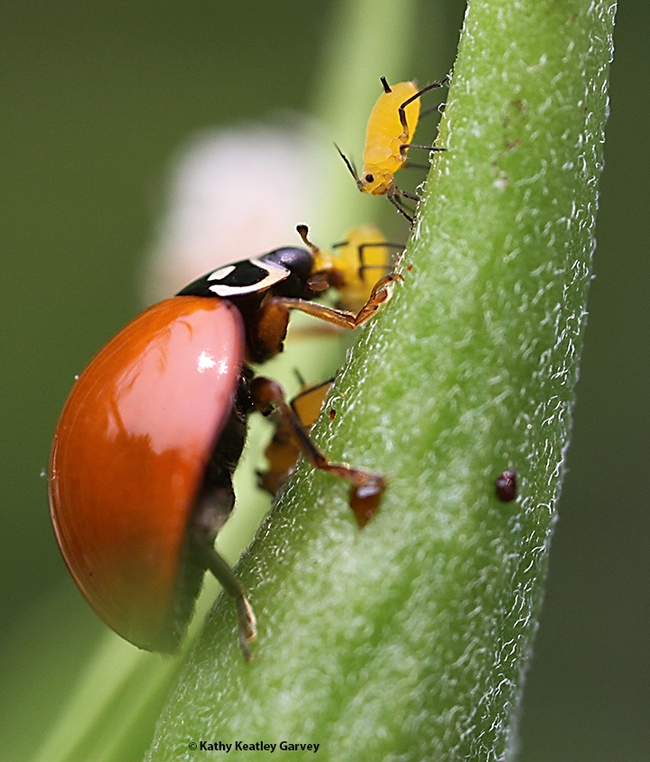
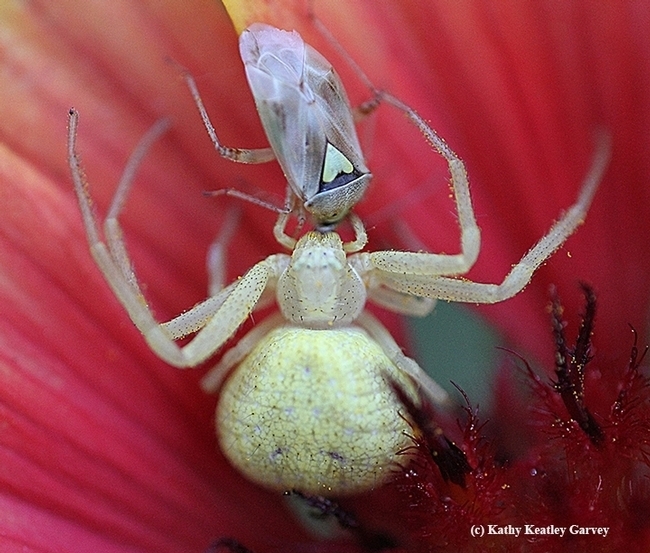
- Author: Kathy Keatley Garvey

If you love numerical palindromes, Kimsey's birthday last year fell on 2-1-21, and Bohart associate Greg Kareofelas' birthday this year fell on 2-2-22. (Note February's next numerical paiindrome is 2-22-22.)
This year the Bohart Museum, home of a worldwide collection of eight million insect specimens, is celebrating its 75th year. Let's just say that Kimsey is younger than that.
So, a quick update with Professor Kimsey:
Q. "What fascinates you about insects?"
A. "All the incredibly weird things they do. Every year I learn something head-slappingly new!"
Q. "What do you want the public to know the most about insects?"
A. "That insects are mostly harmless and really important parts of our lives as well as other animals and plants."
Q. "What's your next project?"
A. "Right now I'm working on two book projects: the Mosquitoes of California and Keys to the Insects of California."
Q. "What insect has the longest life span?"
A. "Depends on how you define it. Desert insects can stay in diapause for up to 10 years or more. Jerry Powell at UC Berkeley discovered that the yucca moth can remain in the pupa for several decades before emerging when it rains. As for adult insects, probably stink beetles live the longest here."
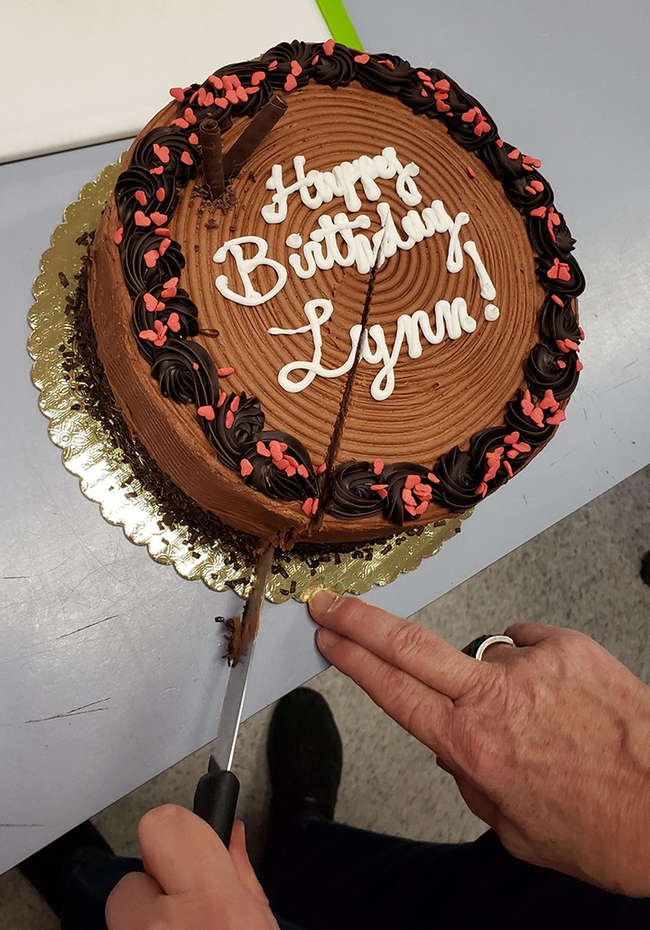
Professor Kimsey is an alumnus of UC Davis. She received her undergraduate degree in 1975 and her doctorate in 1979. Richard M. Bohart, for whom the insect museum is named, served as her major professor and she was his last graduate student.
Kimsey joined the UC Davis entomology faculty in 1989. Her areas of expertise include insect biodiversity, systematics and biogeography of parasitic wasps, urban entomology, civil forensic entomology, and arthropod-related industrial hygiene. She is a recognized global authority on the systematics, biogeography and biology of the wasp families, Tiphiidae and Chrysididae.
Kimsey has served in numerous leadership roles at the international, national and local level, including two terms as president of the International Hymenopterists, board member of the Natural Science Collections Alliance, and interim chair and vice chair (twice) of the UC Davis Department of Entomology (now the Department of Entomology and Nematology).
In 2020, the Pacific Branch, Entomological Society of America (PBESA), presented her with its highest honor, the C. W. Woodworth Award. She earlier received two other PBESA awards: the Systematics, Evolution and Biodiversity Award in 2014, and shared the Team Award in 2013 with colleagues Eric Mussen, Robbin Thorp, Neal Williams and Brian Johnson, who were recognized for their collaborative work specializing in honey bees, wild bees and pollination issues through research, education and outreach.
Known for her decades of public service, Kimsey received the UC Davis Academic Senate Distinguished Scholarly Public Service Award in 2016.
The Bohart Museum is located in Room 1124 of the Academic Surge Building on Crocker Lane, UC Davis campus. In addition to its eight million insect specimens, it houses a live "petting zoo" (think Madagascar hissing cockroaches, stick insects and tarantulas) and a gift shop (now online), stocked with insect-themed gifts such as books, posters, jewelry, t-shirts and hoodies.
Questions? Will the 75th anniversary celebration of the Bohart Museum continue this year? When will the Bohart Museum be open to the public and when will it begin hosting its ever-popular open houses? To be determined, but spoiler alert: One event will involve the California dogface butterfly, Zerene eurydice, the state insect. This is the 50th anniversary of when the State Legislature named the butterfly the state insect. Stay tuned.
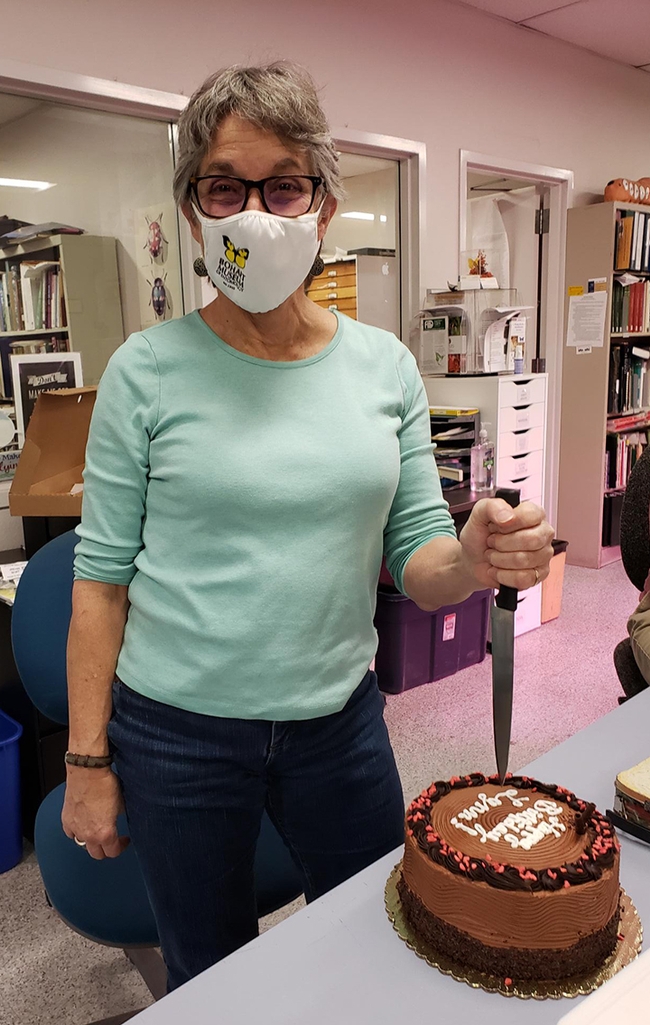
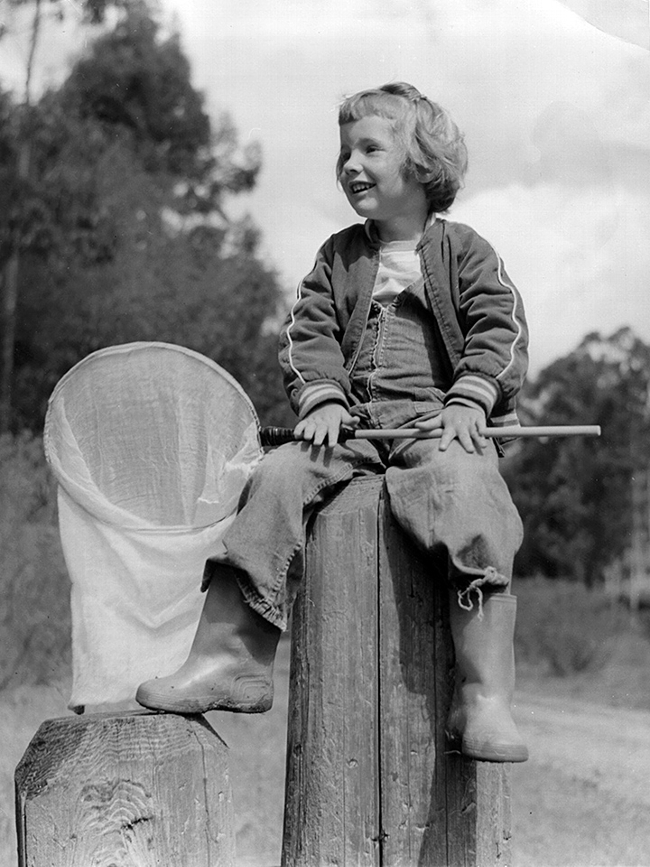
- Author: Kathy Keatley Garvey
It's a damsel, but not in distress.
It's a Familiar Bluett, but it's not all that familiar--unless you study Odonata.
Lately we've been seeing scores of damseflies zigzagging in our pollinator garden in Vacaville, Calif. Seven showed up at one time on our soon-to-bloom Mexican sunflower (genus Tithonia). They found some prey and decided to stay...for awhile.
Greg Karofelas, an associate at the Bohart Museum of Entomology, UC Davis, identified the damselflies as the Familiar Bluett, (Enallagma civile), family Coenagrionidae. They are native to much of the United States and southern Canada.
"The name fits time of the year, and locality, males are light blue, females dark," Karofelas commented. "Enallagma is a genus with a bunch of very similar looking damselflies--they can be hard to identify, even under 10X magnification, in hand."
This species of damselfly belongs to the order Odonata (dragonflies and damselfies), suborder Zygoptera (damselflies), family Coenagrionidae (narrow-winged damselflies);genus Enallagma (American Bluets), and species
civile (Familiar Bluet).
Wikipedia describes damselflies as "an ancient group," insects that have existed since at least the lower Permian. "All damselflies are predatory; both nymphs and adults eat other insects. The nymphs are aquatic, with different species living in a variety of freshwater habitats including acid bogs, ponds, lakes and rivers."
Watch for them! They're the insect version of the flying needles, and their fabric is our landscapes.
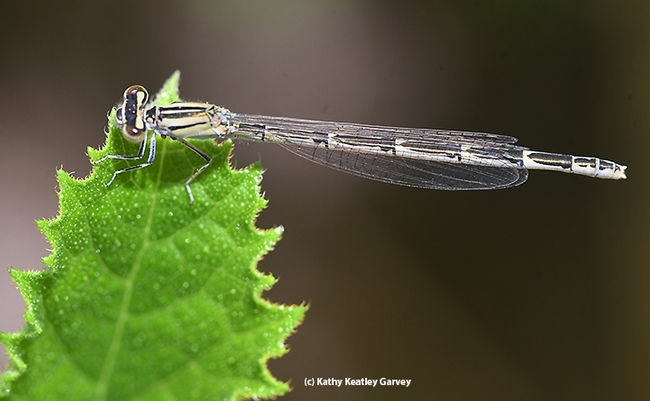
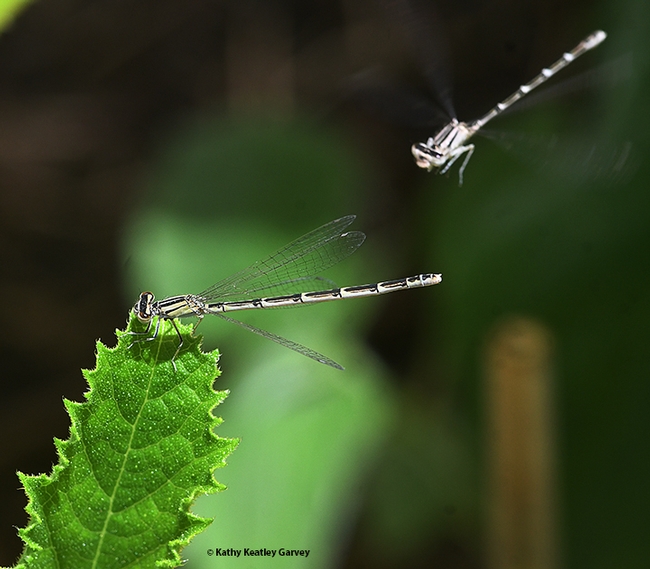
- Author: Kathy Keatley Garvey
What a night--both inside and outside the Bohart Museum of Entomology at the University of California, Davis on Saturday, July 21.
While moths and other insects fluttered to the blacklighting display, visitors flocked inside the museum to see the specimens, and engage one-on-one with scientists.
The UC Davis event was the first in a series of summer weekend programs. In fact, "Moth Night" is the only Bohart Museum public event held at night; it takes place annually in conjunction with National Moth Week, a celebration of the beauty, life cycles and habitats of moths. (See yesterday's Bug Squad blog on blacklighting and the moth families recorded by "Moth Man" John DeBenedictis.)
Inside the Bohart Museum last Saturday, retired entomologist Norm Smith, who received his doctorate at UC Davis studying with major professor Richard Bohart (for whom the museum is named) fielded questions about moths and field collecting, as did senior museum scientist Steve Heydon, and Bohart Museum associates Jeff Smith (who curates the butterfly and moth section) of Rocklin; Greg Kareofelas of Davis, naturalist and insect photographer; entomologist Fran Keller, assistant professor at Folsom Lake College (she holds a doctorate in entomology from UC Davis) and entomologist and college student Noah Crockette of Sacramento.
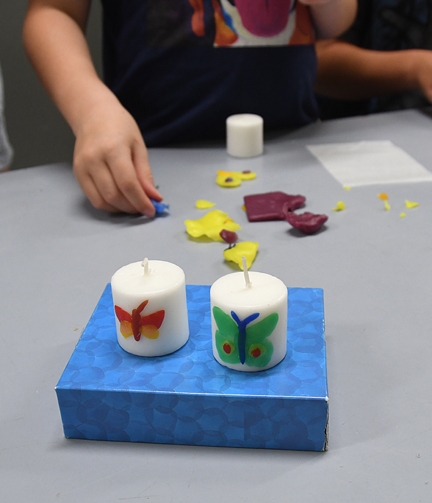
Among the specimen attractions was the white witch moth (Thysania agrippina), which at 11 inches, holds the record for largest wingspan in insects. The caterpillar of this moth can reach 7 inches long. The species is found in Mexico and Central and South America.
Moths are among the most diverse and successful organisms on earth. Scientists estimate there are 150,000 to more than 500,000 moth species. Most are nocturnal.
Visitors enjoyed cookies and hot chocolate. Common Grounds, a Davis coffee shop, provided the large containers of hot water, said Tabatha Yang, education and outreach coordinator. The family craft activity involved decorating wax candles with moth and butterfly replicas.
Meanwhile, Bohart officials are gearing up for the two remaining summer programs, which are free, open to the public, and family friendly:
- "Fire and Ice: Extreme California Insects," set from 1 to 4 p.m., Sunday, Aug. 19.
- "Crafty Insects," set from 1 to 4 p.m., Saturday, Sept. 22.
The Bohart Museum is located in held Room 1124 of the Academic Surge Building, Crocker Lane. Directed by Lynn Kimsey, professor of entomology at UC Davis, the museum houses a global collection of nearly eight million specimens. It is also the home of the seventh largest insect collection in North America, and the California Insect Survey, a storehouse of the insect biodiversity. In addition to the petting zoo, the museum features a year-around gift shop, which is stocked with T-shirts, sweatshirts, books, jewelry, posters, insect-collecting equipment and insect-themed candy.
The Bohart Museum's regular hours are from 9 a.m. to noon and 1 to 5 p.m. Mondays through Thursdays. It is closed to the public on Fridays, Saturdays and Sundays and on major holidays. Admission is free.
More information on the Bohart Museum is available on the website or by contacting (530) 752-0493 or emailing bmuseum@ucdavis.edu.
